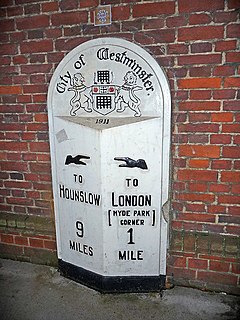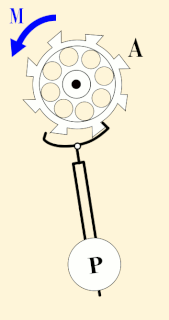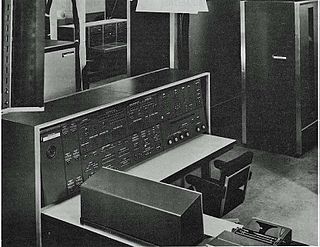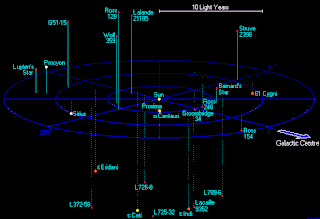Related Research Articles

The mile, sometimes the international mile or statute mile to distinguish it from other miles, is a British imperial unit and US customary unit of distance; both are based on the older English unit of length equal to 5,280 English feet, or 1,760 yards. The statute mile was standardised between the British Commonwealth and the United States by an international agreement in 1959, when it was formally redefined with respect to SI units as exactly 1,609.344 metres.

The second is the base unit of time in the International System of Units (SI), commonly understood and historically defined as 1⁄86400 of a day – this factor derived from the division of the day first into 24 hours, then to 60 minutes and finally to 60 seconds each. Analog clocks and watches often have sixty tick marks on their faces, representing seconds, and a "second hand" to mark the passage of time in seconds. Digital clocks and watches often have a two-digit seconds counter. The second is also part of several other units of measurement like meters per second for speed, meters per second per second for acceleration, and cycles per second for frequency.

The speed of light in vacuum, commonly denoted c, is a universal physical constant important in many areas of physics. Its exact value is defined as 299792458 metres per second. It is exact because, by international agreement, a metre is defined as the length of the path travelled by light in vacuum during a time interval of 1⁄299792458 second. According to special relativity, c is the upper limit for the speed at which conventional matter, energy or any signal carrying information can travel through space.
A nanosecond (ns) is an SI unit of time equal to one billionth of a second, that is, 1⁄1 000 000 000 of a second, or 10−9 seconds.

A microsecond is an SI unit of time equal to one millionth of a second. Its symbol is μs, sometimes simplified to us when Unicode is not available.
The metre per second is an SI derived unit of both speed and velocity, equal to the speed of a body covering a distance of one metre in a time of one second.
A picosecond is an SI unit of time equal to 10−12 or 1⁄1 000 000 000 000 of a second. That is one trillionth, or one millionth of one millionth of a second, or 0.000 000 000 001 seconds. A picosecond is to one second as one second is to approximately 31,689 years. Multiple technical approaches achieve imaging within single-digit picoseconds: for example, the streak camera or intensified CCD (ICCD) cameras are able to picture the motion of light.
The light-second is a unit of length useful in astronomy, telecommunications and relativistic physics. It is defined as the distance that light travels in free space in one second, and is equal to exactly 299,792,458 metres (983,571,056 ft).
Delay line memory is a form of computer memory, now obsolete, that was used on some of the earliest digital computers. Like many modern forms of electronic computer memory, delay line memory was a refreshable memory, but as opposed to modern random-access memory, delay line memory was sequential-access.

The UNIVAC LARC, short for the Livermore Advanced Research Computer, is a mainframe computer designed to a requirement published by Edward Teller in order to run hydrodynamic simulations for nuclear weapon design. It was one of the earliest supercomputers.
The pulse repetition frequency (PRF) is the number of pulses of a repeating signal in a specific time unit, normally measured in pulses per second. The term is used within a number of technical disciplines, notably radar.

The SCR-584 was an automatic-tracking microwave radar developed by the MIT Radiation Laboratory during World War II. It was one of the most advanced ground-based radars of its era, and became one of the primary gun laying radars used worldwide well into the 1950s. A trailer-mounted mobile version was the SCR-784.
A radar system uses a radio-frequency electromagnetic signal reflected from a target to determine information about that target. In any radar system, the signal transmitted and received will exhibit many of the characteristics described below.

The AN/FPS-16 is a highly accurate ground-based monopulse single object tracking radar (SOTR), used extensively by the NASA manned space program, the U.S. Air Force and the U.S. Army. The accuracy of Radar Set AN/FPS-16 is such that the position data obtained from point-source targets has azimuth and elevation angular errors of less than 0.1 milliradian and range errors of less than 5 yards (5 m) with a signal-to-noise ratio of 20 decibels or greater.

The AN/FPS-17 was a ground-based fixed-beam radar system that was installed at three locations worldwide, including Pirinçlik Air Base in south-eastern Turkey, Laredo, Texas and Shemya Island, Alaska.

The light-year, alternatively spelled lightyear, is a unit of length used to express astronomical distances and is equivalent to about 9.46 trillion kilometers (9.46×1012 km) or 5.88 trillion miles (5.88×1012 mi). As defined by the International Astronomical Union (IAU), a light-year is the distance that light travels in vacuum in one Julian year (365.25 days). Because it includes the word "year", the term light-year is sometimes misinterpreted as a unit of time.
Measurements of neutrino speed have been conducted as tests of special relativity and for the determination of the mass of neutrinos. Astronomical searches investigate whether light and neutrinos emitted simultaneously from a distant source are arriving simultaneously on Earth. Terrestrial searches include time of flight measurements using synchronized clocks, and direct comparison of neutrino speed with the speed of other particles.

120 Squadron SAAF was a South African Air Force squadron formed in 1970 to operate the South African/French Cactus surface-to-air missile systems in an air defence role. The unit was disbanded when the Cactus system was retired from service in the late 1980s.
The AR-3D was a military air traffic control and early warning radar developed by Plessey and first produced in 1975. It used a pencil beam and simple frequency scanning system known as "squint scan" to produce a low-cost 3D radar system that was also relatively mobile. About 23 were produced in total and found sales around the world into the early 1980s.